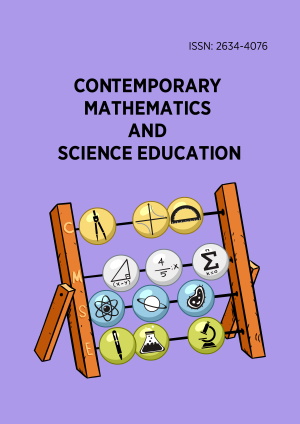Research Article
Research Types in Science Education Journal Articles: Identifying Major Trends
More Detail
1 Department of Elementary Education, School of Humanities, University of the Aegean, Rhodes, GREECE* Corresponding Author
Contemporary Mathematics and Science Education, 3(1), January 2022, ep22006, https://doi.org/10.30935/conmaths/11815
Submitted: 23 December 2021, Published: 27 February 2022
OPEN ACCESS 1346 Views 1061 Downloads
ABSTRACT
This study aims to identify the research types that authors of science education journal articles tend to select for their studies. It focused on articles published during the last decade. Selection of the appropriate research type is a significant process in education research. Depending on factors such as the goals that the researchers set or the conditions within which they work, they may select the implementation of quantitative studies, such as experimental study, field survey, secondary data analysis, and case research. They may select the implementation of qualitative studies such as case study, focus group, action research, and ethnography. Finally, they may select the implementation of mixed study. Therefore, by researching the types of research in published articles it is possible to gain insights about what goals the researchers set and their work context. This was the objective of this research. 2,071 articles in refereed journals in science education were collected. These articles were published between 2011-2020. The methodology included descriptive statistics and distribution calculation through a Kolmogorov Smirnov test. The findings showed that there is a preference to the qualitative type, even though there is a considerable number of studies to other types as well.
CITATION (APA)
Karampelas, K. (2022). Research Types in Science Education Journal Articles: Identifying Major Trends. Contemporary Mathematics and Science Education, 3(1), ep22006. https://doi.org/10.30935/conmaths/11815
REFERENCES
- Bhattacherjee, A. (2012). Social science research: Principles, methods and practices. Create Space Independent Publishing Platform. http://scholarcommons.usf.edu/oa_textbooks/3
- Botes, W. (2021). The development and use of improvised science-teaching models: A case of natural science pre-service teachers. International Journal of Learning, Teaching and Educational Research, 20(5), 18-37. https://doi.org/10.26803/ijlter.20.5.2
- Callon, M., Courtial, J. P., Turner, W. A., & Bauin, S. (1983). From translations to problematic networks: An introduction to co-word analysis. Social Science Information, 22(2), 191-235. https://doi.org/10.1177/053901883022002003
- Cavas, B., Cavas, P., Ozdem, Y., Rannikmae, M., & Ertepinar, H. (2012). Research trends in science education from the perspectives of Journal of Baltic Science Education: A content analysis from 2002 to 2011. Journal of Baltic Science Education, 11(1), 94-102.
- Chang, Y.-H., Chang, C.-Y., & Tseng, Y.-H. (2009). Trends of science education research: An automatic content analysis. Journal of Science Education and Technology, 19(4), 315-331. https://doi.org/10.1007/s10956-009-9202-2
- Cobo, M. J., López-Herrera, A. G., Herrera-Viedma, E., & Herrera, F. (2011). Science mapping software tools: Review, analysis, and cooperative study among tools. Journal of the American Society for Information Science and Technology, 62(7), 1382-1402. https://doi.org/10.1002/asi.21525
- Cohen L., Manion L., & Morrison, K. (2011). Research methods in education. Routledge. https://doi.org/10.4324/9780203720967
- De Jong, O. (2007). Trends in western science curricula and science education research: A bird’s eye view. Journal of Baltic Science Education, 6(1), 15-22.
- Donthu, N., Kumar, S., Mukherjee, D., Pandey, N., & Lim, W. M. (2021). How to conduct a bibliometric analysis: An overview and guidelines. Journal of Business Research, 133, 285-329. https://doi.org/10.1016/j.jbusres.2021.04.070
- Fraser, B. J., Tobin, K. G., & McRobbie, C. J. (Eds). (2012). Second international handbook of science education. Springer. https://doi.org/10.1007/978-1-4020-9041-7
- Kazempour, M., Amirshokoohi, A., & Blamey, K. (2020). Putting theory to practice: Teaching the 5E learning cycle through immersive experiences for pre-service teachers. European Journal of Science and Mathematics Education, 8(1), 67-75. https://doi.org/10.30935/scimath/9547
- Lin, T.-J., Lin, T.-C., Potvin, P., & Tsai, C.-C. (2018). Research trends in science education from 2013 to 2017: A systematic content analysis of publications in selected journals. International Journal of Science Education, 41(3), 367-387. https://doi.org/10.1080/09500693.2018.1550274
- McCollough, C., Wolff-Murphy, S., & Blalock, G. (2019). Reforming science teacher education with cultural reflection and practice. International Journal of Learning, Teaching and Educational Research, 18(1), 31-49. https://doi.org/10.26803/ijlter.18.1.3
- National Research Council. (2012). A framework for K-12 science education: Practices, crosscutting concepts, and core ideas. The National Academies Press. https://doi.org/10.17226/13165
- NGSS. (2013). Next generation science standards, science and engineering practices in the NGSS. http://www.nextgenscience.org/next-generation-science-standards
- OECD. (2000). Measuring student knowledge and skills: The PISA 2000 assessment of reading, mathematical and scientific literacy. OECD Publishing. https://doi.org/10.1787/9789264181564-en
- OECD. (2006). Assessing scientific, reading and mathematical literacy: A framework for PISA 2006. OECD Publishing. https://doi.org/10.1787/9789264026407-en
- OECD. (2019). PISA 2018 results (volume II): Where all students can succeed, PISA. OECD Publishing. https://doi.org/10.1787/b5fd1b8f-en
- Pring, R., (2000). Philosophy of educational research. Continuum. https://doi.org/10.1111/1467-8527.t01-1-00129
- Salini, S. (2016). An introduction to bibliometrics. In T. Greenfield, & S. Greener (Eds.), Research methods for postgraduates (pp. 130-143). John Wiley & Sons, Ltd. https://doi.org/10.1002/9781118763025.ch14
- Szyjka, S. (2012). Understanding research paradigms: Trends in science education research. Problems of Education in the 21st Century, 43, 110-119. https://doi.org/10.33225/pec/12.43.110
- Tobin, K., & Kincheloe, J. L. (Eds). (2006). Doing educational research: A handbook. Sense Publishing. https://doi.org/10.1163/9789087901202
- Tobin, K., & Steinberg, S. R. (Eds). (2015). Doing educational research: A handbook. Sense Publishing. https://doi.org/10.1163/9789463000765
- Tsai, C.-C., & Wen, M. L. (2005). Research and trends in science education from 1998 to 2002: A content analysis of publication in selected journals. International Journal of Science Education, 27(1), 3-14. https://doi.org/10.1080/0950069042000243727
- Viro, E., Lehtonen, D., Joutsenlahti, J., & Tahvanainen, V. (2020). Teachers’ perspectives on project-based learning in mathematics and science. European Journal of Science and Mathematics Education, 8(1), 12-31. https://doi.org/10.30935/scimath/9544
- Walliman, N., (2011). Research methods: The basics. Routledge. https://doi.org/10.4324/9780203836071
- White, R. (1997). Trends in research in science education. Research in Science Education, 27(2), 215-221. https://doi.org/10.1007/BF02461317
- Zupic, I., & Čater, T. (2014). Bibliometric methods in management and organization. Organizational Research Methods, 18(3), 429-472. https://doi.org/10.1177/1094428114562629

 The articles published in this journal are licensed under the CC-BY Creative Commons Attribution International License.
The articles published in this journal are licensed under the CC-BY Creative Commons Attribution International License.